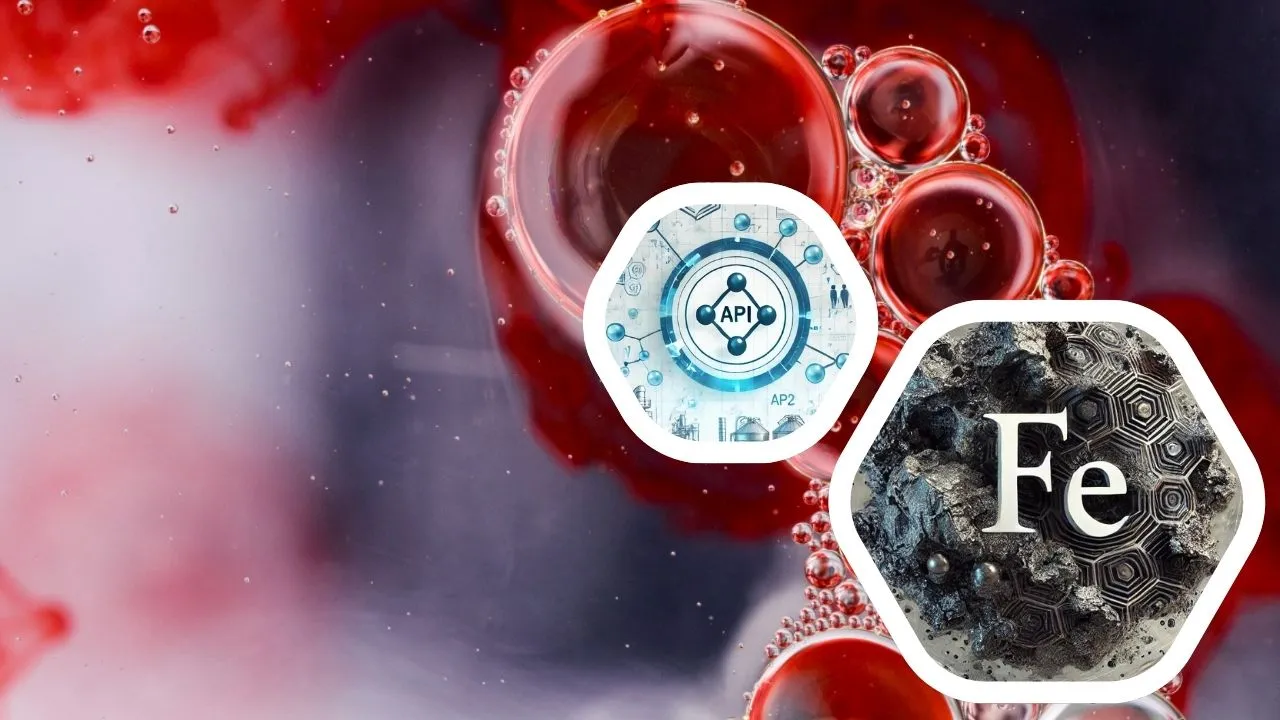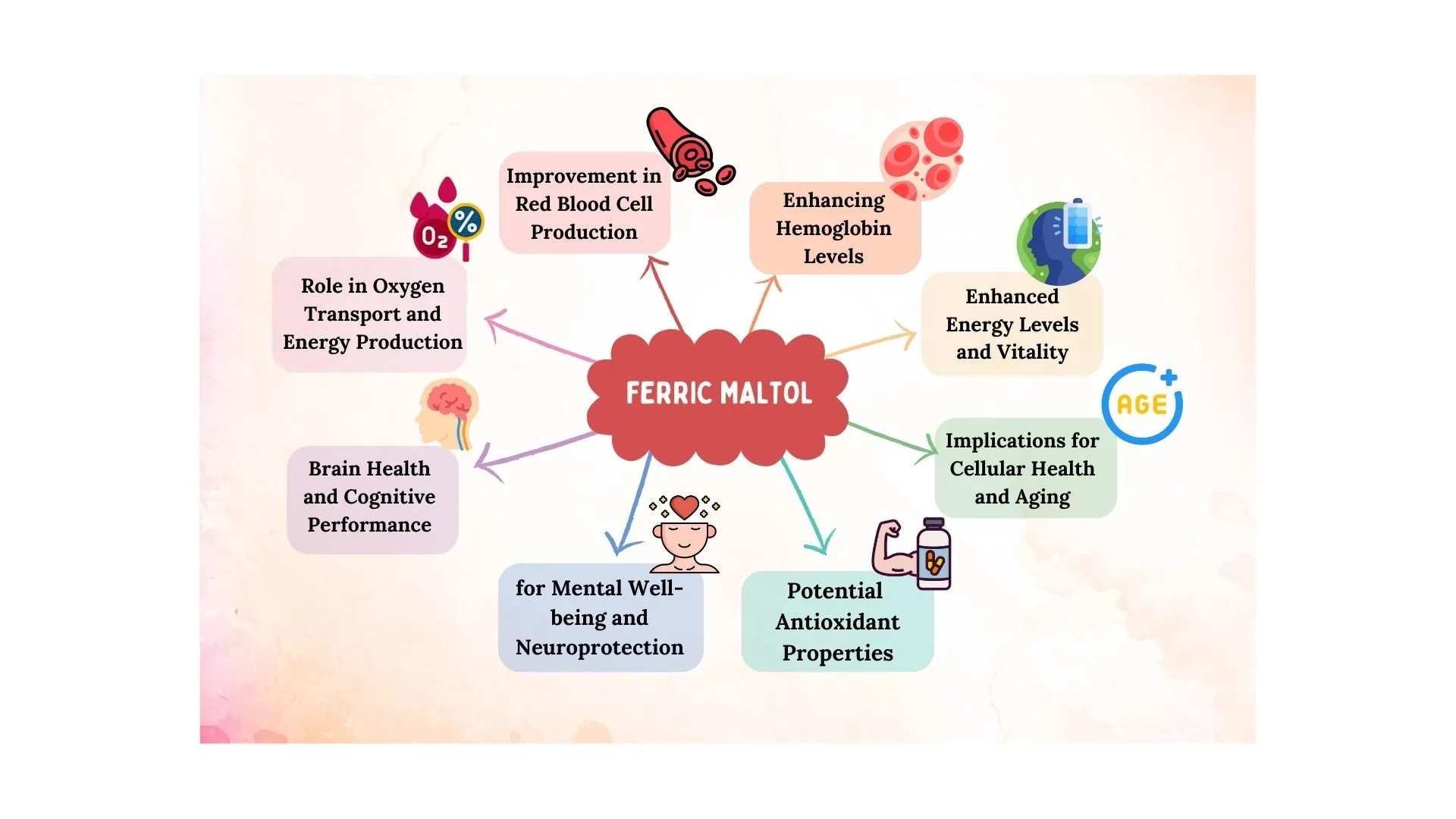9 Top Health Benefits of Ferric Maltol
Ferric maltol is an innovative oral iron therapy composed of a stable complex of ferric (Fe3+) iron and maltol (3-hydroxy-2-methyl-4-pyrone), a naturally occurring sugar derivative found in fruits and roasted barley. The complex is formed with a 3:1 iron-to-maltol ratio, which prevents the formation of iron hydroxide polymers, ensuring bioavailable iron at the neutral pH of the intestinal tract. [1]
Chemical Composition and Properties
This iron API is characterized by its unique chemical structure, which consists of a ferric iron (Fe3+) ion complexed with maltol, a natural organic compound derived from the decomposition of starch. The chemical formula for ferric maltol is C18H15FeO9, and its molecular weight is approximately 431.154 g·mol. [1,2,3]
Development and Evolution of Ferric Maltol
The development of ferric maltol as a pharmaceutical compound involved a series of key milestones:
By the mid-20th century, scientists successfully synthesized ferric maltol, combining ferric iron (Fe3+) with maltol. This combination was found to enhance the solubility and stability of ferric iron, addressing the absorption challenges associated with traditional iron supplements.
Preclinical Studies: Early preclinical studies demonstrated the potential of ferric maltol in improving iron absorption. Animal models showed promising results, with higher bioavailability and reduced gastrointestinal irritation compared to ferrous iron supplements.
Clinical Trials: The positive preclinical results led to clinical trials in humans. These trials aimed to evaluate the safety, efficacy, and tolerability of ferric maltol in treating iron deficiency anemia. The outcomes were encouraging; showing that it effectively increased hemoglobin levels and replenished iron stores with fewer side effects.
Regulatory Approval and Current Status
Europe involved a key regulatory milestone. In February 2016, the European Medicines Agency (EMA) granted marketing authorization for Feraccru, a medication containing ferric maltol. Ferric maltol has navigated a successful path through regulatory hurdles to become a recognized treatment for iron deficiency in adults.
Following pre-clinical development, ferric maltol first achieved marketing authorization in the European Union in 2017. Shortly after, in October 2018, developers submitted a New Drug Application (NDA) to the US Food and Drug Administration (FDA) for approval.
The FDA assigned a target review date in December 2018, and by July 2019, ferric maltol received the green light for use in the United States. These milestones represent the key steps ferric maltol took to gain acceptance as a legitimate treatment option. [6,12,13]
Market Introduction
Following regulatory approval, it was introduced to the market as a prescription medication. Its unique properties, including enhanced absorption and reduced gastrointestinal side effects, positioned it as a valuable alternative to traditional iron supplements.
Current Applications of Ferric Maltol
Today, this API is widely used to treat iron deficiency anemia, particularly in patients who cannot tolerate other forms of iron supplementation. It is especially beneficial for individuals with chronic conditions such as inflammatory bowel disease (IBD) and chronic kidney disease (CKD), where iron deficiency is common, and traditional iron supplements are often poorly tolerated. [4,5]

Importance in Nutritional Science: Exploring the role of this iron API in addressing nutritional deficiencies, its impact on overall health, and its potential as a key player in nutritional science advancements.
Solubility and Bioavailability
Ferric Maltol exhibits favorable solubility in aqueous and slightly acidic environments, making it highly effective for oral administration. This solubility is crucial as it ensures that the compound remains stable and dissolves readily in the gastrointestinal tract, facilitating the release of ferric ions. The maltol component acts as a chelator, binding to the ferric ions and enhancing their solubility, which is a significant advantage over traditional iron salts that often suffer from poor solubility and stability issues. It involves evaluating how efficiently these iron formulations are absorbed and utilized by the body.
It is known for its high bioavailability. It stands out among oral iron supplements due to its high bioavailability and lower incidence of gastrointestinal side effects, making it a more tolerable option for many patients. [7]
In contrast, traditional iron salts like ferrous sulfate, ferrous gluconate, and ferrous fumarate, while effective, are often associated with significant gastrointestinal discomfort.
Intravenous iron formulations such as iron sucrose and ferric carboxymaltose offer the highest bioavailability but come with the need for medical supervision and potential risks associated with intravenous therapy.
This iron API enhances the solubility and absorption of iron in the gastrointestinal tract. It has been shown to be effective in increasing hemoglobin levels in patients with iron deficiency anemia, with fewer gastrointestinal side effects compared to traditional iron salts.
Ferric Maltol vs. Ferrous Sulfate: Ferric maltol has higher bioavailability and fewer gastrointestinal side effects compared to ferrous sulfate.
Ferric Maltol vs. Ferrous Gluconate: Ferric maltol offers better absorption and tolerability than ferrous gluconate.
Ferric Maltol vs. Ferrous Fumarate: Ferric maltol is more bioavailable and causes fewer gastrointestinal issues than ferrous fumarate.
Ferric Maltol vs. Polysaccharide-Iron Complex: Ferric maltol has higher bioavailability, but the polysaccharide-iron complex may be better tolerated in terms of gastrointestinal side effects.

Health Benefits of Ferric Maltol
1. Treatment of Iron Deficiency Anemia
Definition and Causes of Iron Deficiency Anemia:
Iron deficiency anemia is a condition where the body lacks enough iron to produce adequate hemoglobin, leading to reduced oxygen transport in the blood. Common causes include poor dietary intake, chronic blood loss, increased iron needs during pregnancy, and certain medical conditions. [5,6]
How this iron API Addresses Iron Deficiency?
Ferric maltol, a complex of ferric iron and maltol, enhances iron absorption and utilization in the gastrointestinal tract, effectively increasing iron levels in the body.
Clinical Evidence and Case Studies:
Numerous clinical studies have demonstrated that it significantly improves hemoglobin levels in patients with iron deficiency anemia, with fewer gastrointestinal side effects compared to traditional iron salts.
2. Improvement in Red Blood Cell Production
Mechanisms of Red Blood Cell Formation
Red blood cell production, or erythropoiesis, involves the synthesis of hemoglobin in the bone marrow, requiring adequate iron supply. [3,4,9]
Ferric Maltol’s Role in Enhancing Hemoglobin Levels
It provides bioavailable iron, crucial for hemoglobin synthesis, thus supporting efficient red blood cell production.
3. Impact on Overall Blood Health
By increasing hemoglobin levels and supporting erythropoiesis, it contributes to improved blood health and oxygen transport efficiency. [4, 5]
4. Role in Oxygen Transport and Energy Production
Oxygen Transport in the Body
Hemoglobin in red blood cells binds to oxygen in the lungs and releases it in tissues, facilitating cellular respiration and energy production.
5. Ferric Maltol’s Contribution to Efficient Oxygenation
By elevating hemoglobin levels, it enhances the blood’s oxygen-carrying capacity, ensuring efficient oxygen delivery to tissues.
Enhanced Energy Levels and Vitality:
Improved oxygen transport leads to better energy production, increased vitality, and overall enhanced physical performance and well-being.
6. Potential Antioxidant Properties
Understanding Antioxidants and Free Radicals:
Antioxidants neutralize free radicals, preventing cellular damage and reducing oxidative stress, which is linked to aging and various diseases. Emerging research suggests that it may possess antioxidant properties, potentially reducing oxidative stress and promoting cellular health.
7. Implications for Cellular Health and Aging
The antioxidant effects of it could have positive implications for cellular longevity, overall health, and protection against age-related diseases.
8. Impact on Cognitive Function
Brain Health and Cognitive Performance:
Adequate iron levels are essential for optimal brain function, as iron is involved in neurotransmitter synthesis and myelin formation.
Studies Linking Ferric Maltol to Cognitive Benefits:
Some studies indicate that ferric maltol supplementation may improve cognitive function, particularly in individuals with iron deficiency anemia.
9. Considerations for Mental Well-being and Neuroprotection
By addressing iron deficiency, ferric maltol may contribute to better mental well-being and offer neuroprotective benefits, potentially reducing the risk of cognitive decline.
Clinical Studies and Research Findings
Clinical studies have consistently shown that this iron API is effective in treating iron deficiency anemia, enhancing hemoglobin levels, and improving patients’ quality of life with fewer gastrointestinal side effects compared to traditional iron supplements. Additionally, research is ongoing to explore its potential antioxidant properties and benefits for cognitive function and overall health. [7,8,11]
Future Research Directions
Research should focus on assessing the long-term efficacy and safety of ferric maltol across diverse patient populations, including those with chronic conditions like inflammatory bowel disease (IBD) and chronic kidney disease (CKD). This will help in understanding the sustainability of its benefits and identifying any potential long-term adverse effects. [1]
Common Side Effects of Ferric Maltol
Gastrointestinal Issues
Abdominal Pain
Constipation
Diarrhea
Nausea
Headache
Dizziness
Skin Reactions
Precautions
Pre-existing Conditions
Inflammatory Bowel Disease (IBD)
Chronic Kidney Disease (CKD)
Allergic Reactions [10]
Why choose us?
Our Ferric Maltol represents lower dose of iron is preferred for its enhanced absorption. Effectively used as a preventive measure following iron infusion treatments. Experience the benefits of our scientifically formulated Ferric Maltol, designed for optimal absorption and efficacy at WBCIL. Our product ensures a smooth, side-effect-free experience. As one of India’s leading API manufacturers, we are dedicated to delivering products that meet the highest standards of purity and effectiveness.
Conclusion
Ferric Maltol is preferred low-dose iron supplement. Ferric maltol is designed to optimize iron absorption, even at lower doses, due to its unique formulation. The formulation improves the bioavailability of iron, making it effective even in smaller doses. After iron infusion treatments, ferric maltol can be effectively used as a maintenance therapy to sustain iron levels. Its oral administration allows for continued iron supplementation, preventing the recurrence of iron deficiency anemia without the need for frequent intravenous infusions. This makes it a convenient and patient-friendly option for long-term management. Lower doses of ferric maltol reduce the risk of gastrointestinal side effects, which are commonly associated with higher doses of traditional oral iron supplements. This improved tolerability helps enhance patient compliance and overall treatment effectiveness. By utilizing ferric maltol in a lower dose, patients can maintain adequate iron levels efficiently, with fewer side effects, making it a valuable option in both treatment and prevention of iron deficiency anemia
1. Kalantar-Zadeh, K., & Lee, G. H. (2016). The fascinating but deceptive ferritin: To measure it or not to measure it in chronic kidney disease? Clinical Journal of the American Society of Nephrology, 11(9), 1543-1544 https://www.ncbi.nlm.nih.gov/pmc/articles/PMC5089582/
2. https://pubchem.ncbi.nlm.nih.gov/compound/Ferric-Maltol
3. https://gsrs.ncats.nih.gov/ginas/app/beta/substances/MA10QYF1Z0
4. https://commonchemistry.cas.org/detail?cas_rn=33725-54-1
5.https://www.accessdata.fda.gov/drugsatfda_docs/label/2019/212320Orig1s000lbl.pdf
6. https://www.ncbi.nlm.nih.gov/pmc/articles/PMC8509126/
7. https://bmjopengastro.bmj.com/content/8/1/e000530
8. https://read.qxmd.com/read/32633548/ferric-maltol-a-new-oral-iron-formulation-for-the-treatment-of-iron-deficiency-in-adults
9. https://www.mdpi.com/1422-0067/22/11/5546
10. https://www.webmd.com/drugs/2/drug-177626/ferric-maltol-oral/details#:~:text=Constipation%2C%20diarrhea%2C%20gas%2C%20nausea,effect%20that%20is%20not%20harmful.
11. https://pubmed.ncbi.nlm.nih.gov/26595432/
12. https://www.ema.europa.eu/en/medicines/human/EPAR/feraccru
13. https://www.ema.europa.eu/en/documents/product-information/feraccru-epar-product-information_en.pdf
Ferric Maltol works by delivering bioavailable ferric iron to the body. The maltol component helps stabilize the iron, enhancing its solubility and absorption in the gastrointestinal tract, which helps increase iron levels efficiently.
Ferric Maltol is primarily used to treat iron deficiency anemia, especially in patients who cannot tolerate traditional iron supplements. It is beneficial for individuals with chronic conditions like inflammatory bowel disease (IBD) and chronic kidney disease (CKD), where iron deficiency is common.
Ferric Maltol offers higher bioavailability and fewer gastrointestinal side effects compared to traditional iron salts such as ferrous sulfate, ferrous gluconate, and ferrous fumarate. This makes it a more tolerable option for many patients.
Common side effects of Ferric Maltol may include gastrointestinal issues such as abdominal pain, constipation, diarrhea, nausea, headache, dizziness, and skin reactions.
Ferric Maltol is administered orally, typically in the form of capsules. The exact dosage and administration schedule should be determined by a healthcare provider based on individual patient needs.
Patients with pre-existing conditions such as inflammatory bowel disease (IBD) or chronic kidney disease (CKD) should consult their healthcare provider before starting Ferric Maltol, as individual suitability and dosing may vary.
